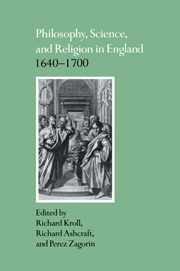Book contents
- Frontmatter
- Contents
- Notes on contributors
- Preface
- 1 Introduction
- Part I The Cambridge Platonists: philosophy at mid century
- 2 Henry More, the Kabbalah, and the Quakers
- 3 Edward Stillingfleet, Henry More, and the decline of Moses Atticus: a note on seventeenth-century Anglican apologetics
- 4 Latitudinarians, neoplatonists, and the ancient wisdom
- 5 Cudworth, More and the mechanical analogy
- 6 Cudworth and Hobbes on Is and Ought
- Part II The Restoration settlement
- Index
5 - Cudworth, More and the mechanical analogy
Published online by Cambridge University Press: 05 November 2011
- Frontmatter
- Contents
- Notes on contributors
- Preface
- 1 Introduction
- Part I The Cambridge Platonists: philosophy at mid century
- 2 Henry More, the Kabbalah, and the Quakers
- 3 Edward Stillingfleet, Henry More, and the decline of Moses Atticus: a note on seventeenth-century Anglican apologetics
- 4 Latitudinarians, neoplatonists, and the ancient wisdom
- 5 Cudworth, More and the mechanical analogy
- 6 Cudworth and Hobbes on Is and Ought
- Part II The Restoration settlement
- Index
Summary
And like an Engin mov'd with wheel and waight, His principles being ceast, he ended straight.
John Milton, “On the University Carrier” (alter)An intriguing feature of Simon Patrick's A Brief Account of the new Sect of Latitude-Men (1662) is its conspicuous inclusion of some reflections upon the New Philosophy, as the full title puts it, meaning the new natural philosophy, the new science, that characterized the first half of the seventeenth century. A priori, there is no obvious reason why we should have expected Patrick to make a connection between characteristically latitudinarian positions and recent advances in natural philosophy. The latter seem to belong exclusively to the scientific domain, the former to areas of controversy within Anglicanism. Yet A Brief Account linked the latitude-men directly with an important feature of the “new philosophy” by crediting them with having “introduced” into England new doctrines of mechanical explanation of natural phenomena as correctives of the explanatory tautologies of peripatetic physics. Patrick illustrated the contrast between the mechanical and the peripatetic philosophies with a lengthy parable of a farmer's faulty clock, the fruitless attempts of “a certain Peripatetick artificer” to mend it, and the intervention of “an ingenuous Gentleman” who, understanding perfectly the mechanical workings of clocks, was able to show the farmer why he needed a new one, and what he should do in future with any other clock that might go out of kilter.
It is not wholly clear from Patrick's pamphlet, which contained the first appearance in print of the terms “latitude-men” and “latitudinarian,” who exactly the latitude-men were.
- Type
- Chapter
- Information
- Philosophy, Science, and Religion in England 1640–1700 , pp. 109 - 127Publisher: Cambridge University PressPrint publication year: 1992
- 2
- Cited by



